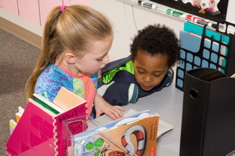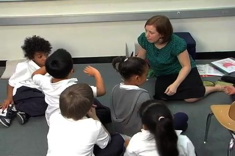In the first few days of school, I overheard teachers, fingers hovering over electronic tablets, warning students who weren’t standing quietly enough in line that they would be losing points for the class. Apparently, “Don’t smile until Christmas” and the public shaming of students through clips on a wheel have married and gone digital in the form of digital classroom management. Classroom management is one of the trickiest parts of being a teacher, but it saddens me to see teachers remove the humanity involved in creating a classroom community built on trust, collaboration, and a growth mind-set by holding their students at arm’s length with a point system.
Last year at curriculum night, when I invited questions from the parents, one swaggering father asked, “What’s your behavior management system?” I was totally unprepared for a question like that. After 30 years, I have learned to work through and with most any behaviors children bring to our classroom, and I’ve heard I have a reputation for being the kind of teacher who can “keep a class in line.” Perhaps the father asking the question just wanted to know how I do it.
How do I do it? I’m not exactly sure. There is no visible system for the way I “manage” my classroom, and it is, in fact, often far from systematic. Even the word management is problematic, because that implies that I am controlling behaviors. But since I have been a teacher for 30 years, I have also learned to stay calm and think quickly. I pointed to the students’ “Words to Live By” quotes they had chosen or created and that lined the wall above the chalkboard, gloriously colored, decorated, and optimistic. “That’s my behavior management system,” I said as I pointed. “Every child is trying to live up to those words they’ve chosen.”
There were two quotes by Ralph Waldo Emerson chosen by students: Always do what you are afraid to do, and Do not go where the path may lead, go instead where there is no path and leave a trail. Others were unattributed, including these:
Life is short. Make it amazing.
The only way to have a friend is to be one.
Always do your very best, no matter what.
My answer, delivered confidently and without hesitation, deflated some of the father’s bluster as everyone looked at the quotes. We moved on to book orders and birthday treats. But I wondered later if he understood how true my off-the-cuff answer really was.
My “classroom management system” is built on a foundation of student self-awareness and self-control. I trust that with practice and encouragement, my students will collaborate, cooperate, and treat each other with kindness and respect.
It is the practice and encouragement piece that I see online classroom management tools removing from the work of the teachers who choose to use them. I have a student this year who just about never stops talking. This prevents him and the people around him from completing work. I’m not going to try to punish this habit out of him. Instead, I am working hard to help him start to build an identity of success. Together, we are studying his chatter and work habits like scientists, noticing when things are going well and when they are not, and trying to do more of the things that result in work getting finished and peers staying on task. Over the course of a few weeks, he is gradually learning to monitor situations and make choices that result in his and others’ work getting completed. And now that he is finally getting to the work at hand, I am realizing that the chatter is often a cover for a lack of understanding and an unwillingness to lose face by asking questions or admitting his struggle. The attitude of success we need to build has broadened from controlling the chatter to understanding and learning the concepts.
My “classroom management system” also includes the hairbrush I bought when I learned that a girl with a perpetual rats’ nest of hair would be in my class. When she comes in looking particularly unkempt, I surreptitiously hand her the brush and suggest she spend a bit of time tidying up. When she’s finished, I help with a last few gentle brushes and a compliment on what a difference she’s made. Last week, she came into the room, walked up to me, and said, “I had time to work on my hair before I left this morning! I think it looks really good!” She’s learning to monitor herself and take control of a situation that helps her start her day with confidence and pride, and it has been accomplished with compassion and patience rather than public shaming.
Trusting that behavior will even out and become at least liveable, if not blissfully calm, is not easy, but it’s one of the most important lessons we can teach. Let’s think big. If our children learn that with self-monitoring and self-control rather than with constant policing by the One In Power, it is possible to live in relative harmony with the 25 others in our classroom, the 75 others on the playground, and the 500 others in the school building, then perhaps we’ve started them on a path for getting along with the millions of others who inhabit our planet.








